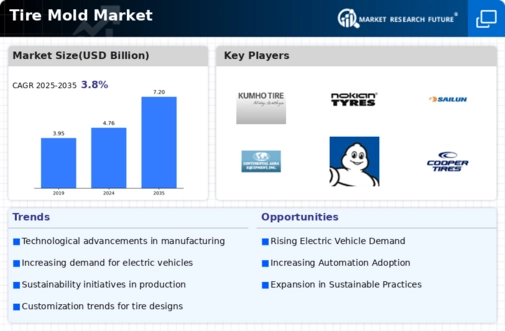Market Growth Projections
The Global Tire Mold Market Industry is poised for substantial growth, with projections indicating a market value of 4.76 USD Billion in 2024 and an anticipated increase to 7.2 USD Billion by 2035. This growth trajectory suggests a compound annual growth rate (CAGR) of 3.84% from 2025 to 2035. Such figures reflect the increasing demand for innovative tire solutions and the ongoing expansion of the automotive sector. The market's evolution is likely to be influenced by various factors, including technological advancements, regulatory changes, and shifts in consumer preferences, all of which will shape the future landscape of tire mold production.
Rising Environmental Regulations
The increasing stringency of environmental regulations is driving changes in the Global Tire Mold Market Industry. Governments worldwide are implementing policies aimed at reducing carbon emissions and promoting sustainable practices within the automotive sector. This regulatory environment compels tire manufacturers to invest in molds that facilitate the production of eco-friendly tires. For example, molds designed for tires made from sustainable materials are becoming more prevalent. As manufacturers adapt to these regulations, the market is likely to see a shift towards molds that support the production of environmentally compliant tires, thereby influencing market dynamics in the coming years.
Emerging Markets and Urbanization
Emerging markets and urbanization trends are reshaping the landscape of the Global Tire Mold Market Industry. As urban populations grow, the demand for personal and commercial vehicles increases, leading to a higher requirement for tires and, consequently, tire molds. Countries in Asia-Pacific and Latin America are experiencing rapid urbanization, which is likely to drive tire production. This trend is expected to contribute to the market's growth, with projections indicating a market value of 7.2 USD Billion by 2035. The need for molds that cater to diverse tire specifications will be crucial in meeting the demands of these burgeoning markets.
Growth of the Automotive Industry
The overall growth of the automotive industry is a fundamental driver of the Global Tire Mold Market Industry. As global vehicle production increases, so does the demand for tires, which directly correlates with the need for tire molds. In 2024, the market is anticipated to reach 4.76 USD Billion, reflecting the robust growth in vehicle manufacturing. Additionally, the expansion of automotive markets in emerging economies is likely to further bolster demand for tire molds. This growth trajectory suggests a sustained increase in production capabilities, which will be essential for meeting the rising demand for tires across various vehicle segments.
Increasing Demand for Electric Vehicles
The rise in electric vehicle adoption is a notable driver for the Global Tire Mold Market Industry. As manufacturers pivot towards producing tires that cater specifically to electric vehicles, the need for specialized molds increases. Electric vehicles often require tires that are optimized for lower rolling resistance and enhanced durability. This shift is expected to contribute to the market's growth, with projections indicating a market value of 4.76 USD Billion in 2024. As the electric vehicle market expands, it is likely that the demand for innovative tire molds will follow suit, thus influencing the overall dynamics of the Global Tire Mold Market Industry.
Technological Advancements in Tire Manufacturing
Technological innovations in tire manufacturing processes are significantly impacting the Global Tire Mold Market Industry. Advanced manufacturing techniques, such as 3D printing and automation, are enhancing the precision and efficiency of tire mold production. These advancements not only reduce production costs but also improve the quality and performance of the tires produced. For instance, the integration of smart technologies allows for real-time monitoring and adjustments during the manufacturing process. As these technologies become more prevalent, the market is expected to grow, with a projected CAGR of 3.84% from 2025 to 2035, reflecting the industry's adaptation to modern manufacturing demands.












